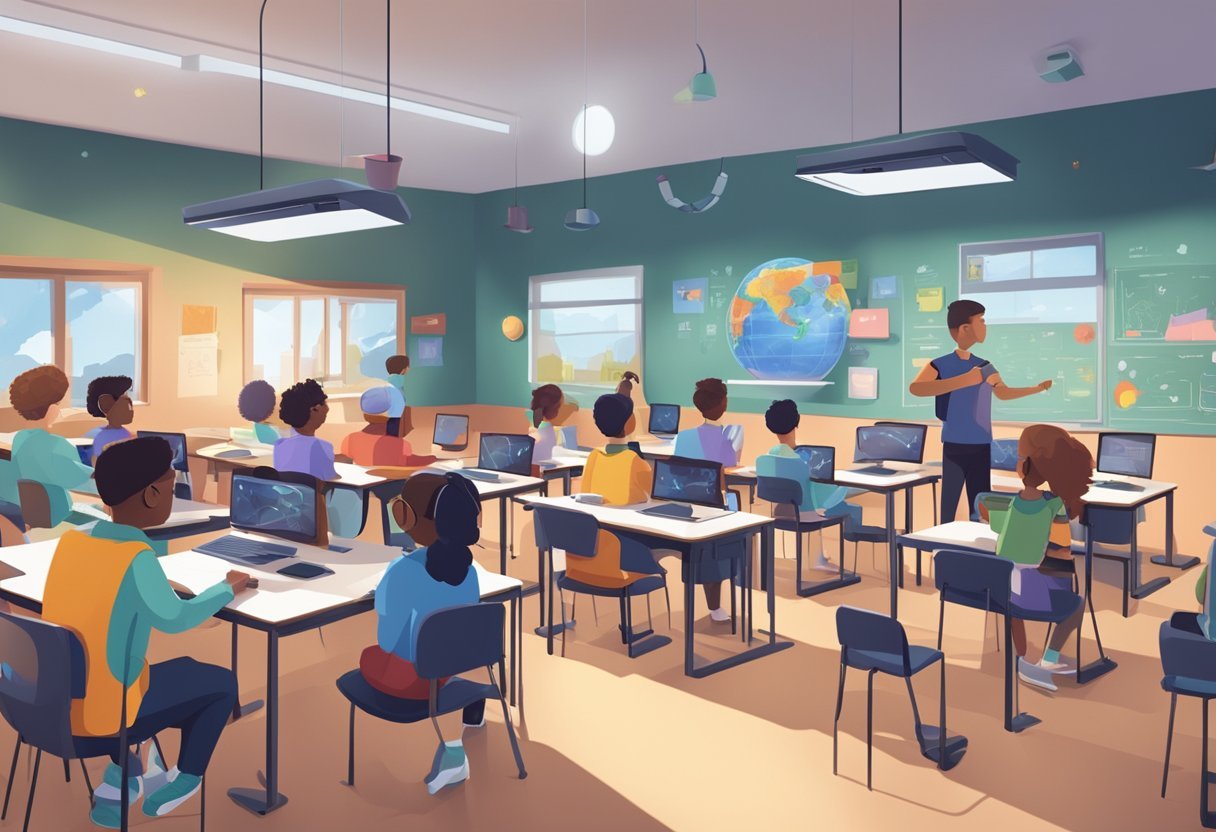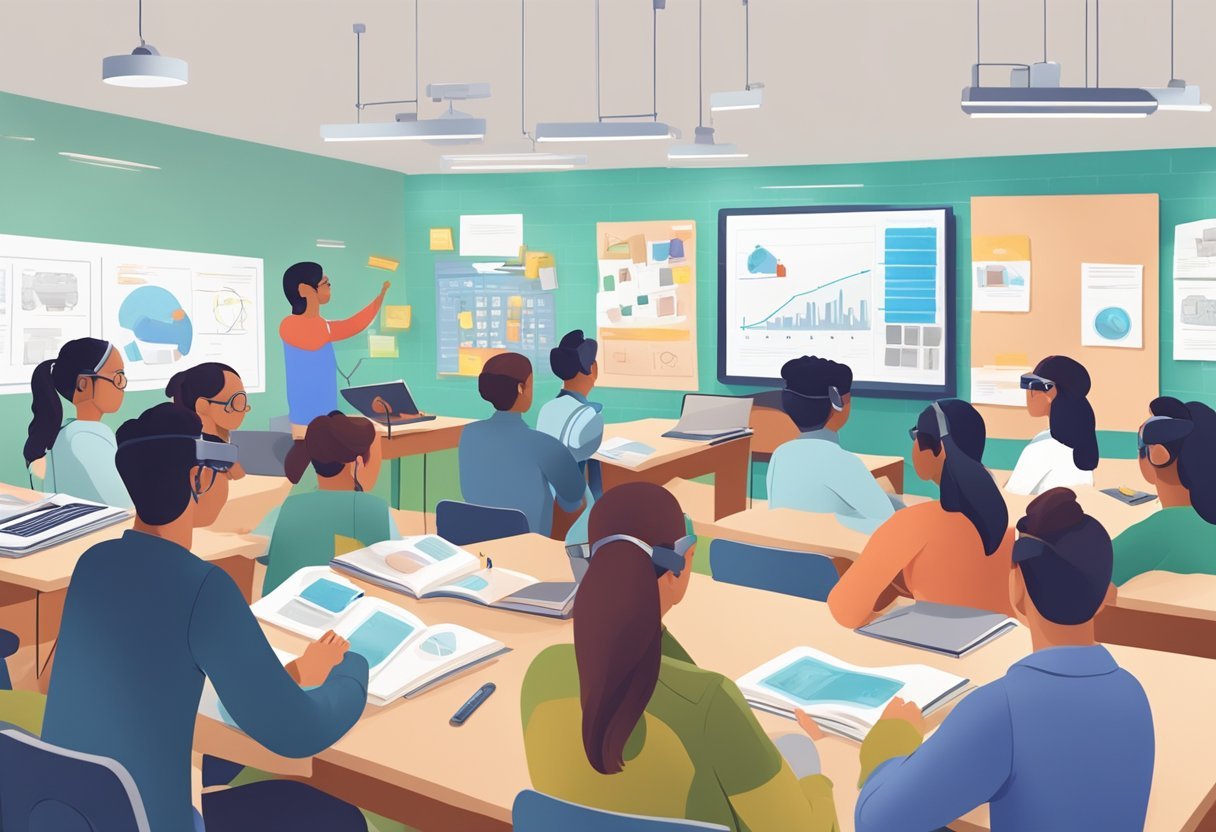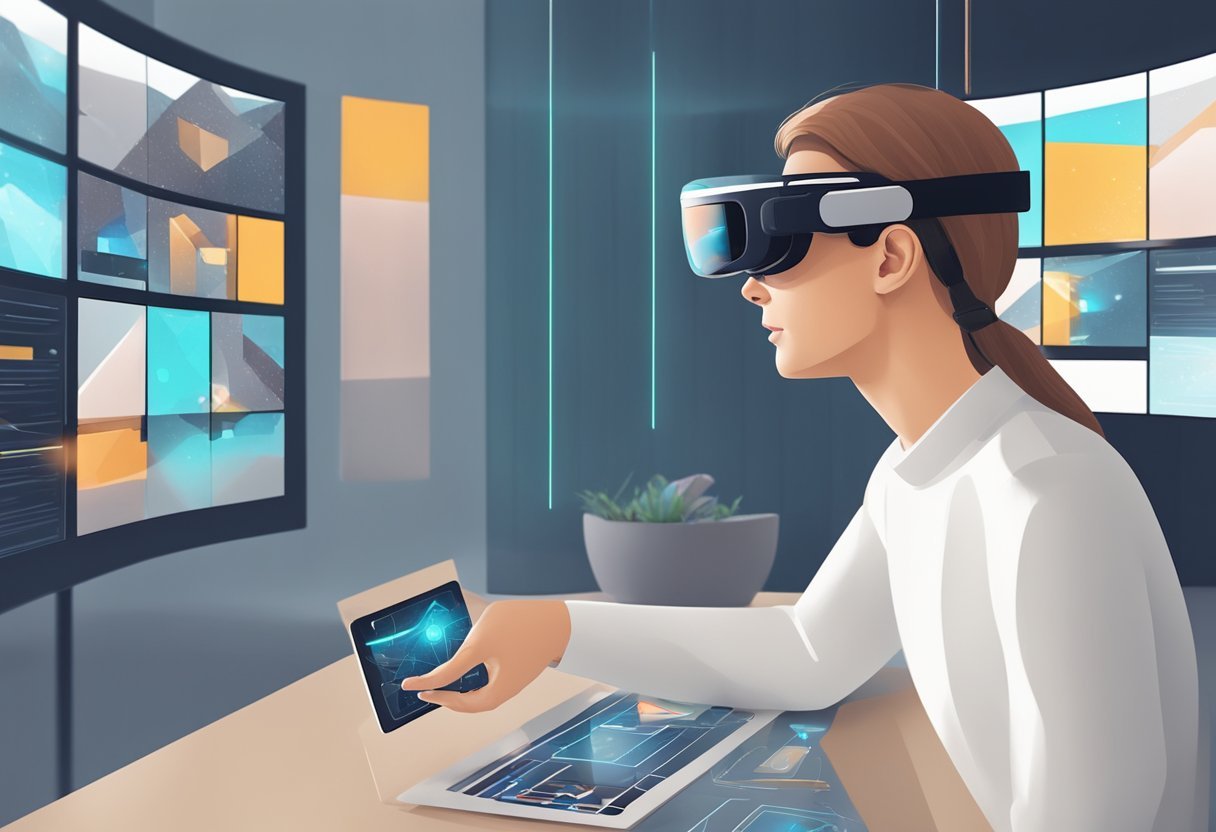Augmented Reality (AR) technology is transforming the education sector by creating interactive and immersive learning experiences. AR technology integrates digital content into the real-world environment to enhance learning, retention, and engagement. With the increasing use of mobile devices and smartphones, AR technology is becoming more accessible and affordable for educational purposes. In this blog post, I will share with you the benefits of using Augmented Reality in education and how AR can benefit students
AR technology is being used in various learning domains, including science, mathematics, history, and art. AR apps provide students with an opportunity to interact with 3D objects, explore their environment, and gain a deeper understanding of concepts. AR technology can also improve collaboration and engagement among students, making learning more enjoyable and effective.
AR technology has the potential to revolutionize the education sector by providing students with interactive and immersive learning experiences. Technological integration and content development are essential for the successful implementation of AR in education. AR technology can improve engagement and collaboration among students, making learning more enjoyable and effective.
Fundamentals of Augmented Reality in Education
Augmented Reality (AR) is an interactive technology that overlays digital information onto the real world. AR enhances the user’s experience by adding computer-generated elements like images, videos, and sounds to the physical environment. AR has become increasingly popular in education due to its ability to create immersive learning experiences for students.
AR technology offers a new way of learning that is more interactive and engaging. With AR, learners can interact with virtual objects and environments in real-time, making learning more exciting and memorable. AR has been applied in various educational settings, from primary schools to universities, to enhance learning outcomes.
AR technology is relevant to learning because it provides learners with a more interactive and engaging learning experience. AR can be used to create simulations, virtual laboratories, and other interactive learning experiences that allow learners to explore complex concepts and ideas in a more visual and interactive way. AR can also be used to create personalized learning experiences that cater to the individual needs and preferences of each learner.
Comparing AR to Virtual Reality in Educational Contexts
AR and Virtual Reality (VR) are two interactive technologies that are used in education to enhance learning outcomes. While both technologies offer immersive learning experiences, they differ in their approach to creating these experiences. AR enhances the real world by overlaying digital information, while VR creates a completely digital environment that simulates the real world.
AR technology is more suitable for educational contexts that require learners to interact with the real world. AR can be used to create interactive learning experiences that allow learners to explore real-world environments and objects. VR, on the other hand, is more suitable for educational contexts that require learners to explore and interact with virtual environments.
Augmented reality technology is a powerful tool that can be used to enhance learning outcomes in various educational settings. AR provides learners with a more interactive and engaging learning experience that can improve their understanding and retention of complex concepts and ideas. While AR and VR are both useful technologies in education, their applications differ depending on the learning objectives and context.
Benefits of Augmented Reality in education

- Enhances multi-sensory learning experiences
- Accommodates various learning styles
- Increases student engagement and motivation
- Offers effective visualization and immersive learning
- Provides a shorter learning curve
- Is budget-friendly and accessible
- Improves academic self-efficacy
- Encourages interactive learning
- Enables real-time feedback and assessment
- Fosters creativity and innovation
Enhances Multi-Sensory Learning Experiences
Augmented Reality (AR) in education enriches the learning environment by providing multi-sensory experiences that are more engaging than traditional 2D resources. By overlaying digital information onto the real world, students can see, hear, and sometimes even touch virtual objects, leading to a deeper understanding of the subject matter.
This multi-sensory approach caters to different learning preferences and can help to solidify knowledge through a combination of visual, auditory, and kinesthetic cues. As a result, complex concepts become more tangible, and learners are able to retain information more effectively.
Accommodates Various Learning Styles
AR technology supports diverse learning styles by offering a variety of ways to interact with educational content. Visual learners can benefit from 3D models that bring textbook diagrams to life, while auditory learners may gain more from AR experiences that include narrations or explanations.
Kinesthetic learners, who learn best through movement and doing, can engage with interactive AR simulations that require physical activity. By catering to visual, auditory, and kinesthetic learners, AR ensures that educational content is accessible and effective for a wider range of students.
Increases Student Engagement and Motivation
The novel and interactive nature of AR can significantly boost student engagement and motivation. When learners interact with AR applications, they are often more intrigued and willing to explore the content, leading to increased attention and interest in the subject matter. This heightened engagement can result in more enthusiastic participation and a stronger desire to learn, which is particularly beneficial for subjects that students may typically find less interesting.
Offers Effective Visualization and Immersive Learning
AR provides students with the ability to visualize concepts and ideas in a way that is not possible with traditional teaching methods. Through 3D visualization, learners can explore structures, historical events, and scientific phenomena up close, making abstract or challenging concepts more understandable. This immersive learning experience allows students to dive deeper into their studies, fostering a more profound comprehension and appreciation for the material.
Provides a Shorter Learning Curve
The intuitive nature of AR technology can lead to a shorter learning curve for students. Instead of spending considerable time trying to grasp complex ideas through text or static images, learners can quickly understand these concepts through interactive AR models. This efficiency in learning not only saves time but also reduces frustration and can lead to better educational outcomes.
Is Budget-Friendly and Accessible
Implementing AR in education can be a cost-effective solution. With the widespread availability of smartphones and tablets, many students already have the necessary devices to access AR applications. Moreover, the development and distribution of digital AR content can be more economical than physical educational resources, making it a practical option for schools and educational institutions operating on tight budgets.
Improves Academic Self-Efficacy
AR has the potential to improve students’ academic self-efficacy by providing hands-on tasks that encourage active participation in the learning process. As students engage with AR tasks, their concentration and involvement in learning activities increase, which can boost their confidence in their academic abilities. This enhanced self-efficacy can lead to better performance and a more positive attitude toward learning.
Encourages Interactive Learning
Interactive learning is a cornerstone of AR in education. Students can manipulate virtual objects, conduct experiments, and explore scenarios that would be impossible or impractical in the real world. This level of interactivity not only makes learning more enjoyable but also encourages critical thinking and problem-solving skills as students work through the challenges presented by AR applications.
Enables Real-Time Feedback and Assessment
AR can offer immediate feedback to students, allowing them to understand their progress and areas for improvement in real-time. This instant assessment can be a powerful tool for both learners and educators, as it facilitates timely corrections and personalized learning paths. AR can help teachers monitor student engagement and comprehension, enabling them to adjust their teaching strategies accordingly.
Fosters Creativity and Innovation
Finally, AR in education fosters creativity and innovation by allowing students to explore and create in ways that were previously unimaginable. With AR, learners can design their own virtual models, experiment with different scenarios, and collaborate with peers in a shared virtual space. This freedom to innovate not only enhances the learning experience but also prepares students for future challenges by developing their creative problem-solving skills.
Technological Integration and Content Development
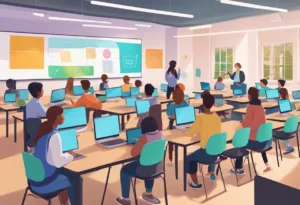
Augmented Reality (AR) technology has the potential to revolutionize the way educational content is created and delivered. By integrating AR technology into educational content, it is possible to create interactive and immersive learning experiences that can engage students in ways that traditional classroom lectures cannot.
Creating Interactive Educational Content
Creating interactive educational content with AR technology can be done using a variety of computer graphics tools and software. To create effective AR content, it is important to understand the principles of graphic design, including color theory, typography, and layout. It is important to consider the needs of the target audience, including their age, interests, and learning styles.
AR technology can be used to create interactive content such as 3D models, animations, and simulations. For example, an AR app could be developed that allows students to explore the human body in 3D, or to simulate chemical reactions in a virtual lab.
Tools and Resources for AR Content Creation
There are many tools and resources available for creating AR content, including software development kits (SDKs), mobile apps, and online tutorials. Some popular SDKs for AR include ARKit for iOS and ARCore for Android. These SDKs provide developers with the tools they need to create AR apps for mobile devices and tablets.
There are also many mobile apps available that allow users to create AR content without any programming knowledge. These apps typically provide users with a library of 3D models and animations that can be placed in the real world using the camera on a mobile device.
AR technology has the potential to revolutionize the way educational content is created and delivered. By integrating AR technology into educational content, it is possible to create interactive and immersive learning experiences that can engage students in ways that traditional classroom lectures cannot. With the availability of tools and resources for AR content creation, it is now easier than ever to create engaging and interactive educational content using AR technology.
AR Applications in Specific Learning Domains
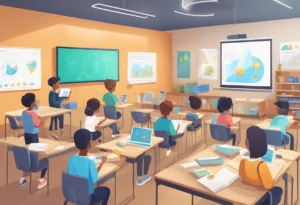
Augmented Reality (AR) technology has been found to be useful in enhancing learning experiences in various fields. In this section, we will explore some of the specific learning domains where AR applications have been implemented successfully.
Enhancing Science and Engineering Education
AR applications have been used to create simulations that enable students to understand complex scientific concepts and engineering principles. For instance, AR simulations can be used to teach students about chemical reactions in a more interactive and engaging way. Students can visualize the molecular structures of different compounds and observe how they react when mixed with other compounds.
Augmenting History and Cultural Heritage Learning
AR technology has also been used to enhance learning experiences in history and cultural heritage sites. AR applications can be used to create virtual tours of historical sites, allowing students to explore and learn about different cultures and historical events. For example, students can use AR-enabled devices to explore ancient ruins and artifacts and learn about the history and significance of these sites.
Applications in Healthcare Training and Anatomy
AR technology has been found to be useful in healthcare training and anatomy education. AR applications can be used to create interactive simulations of human anatomy, allowing students to visualize and explore different parts of the human body. For instance, students can use AR-enabled devices to explore the human heart and learn about its different chambers and functions.
AR technology has the potential to revolutionize the way we learn and teach in various fields. AR applications have been found to be useful in enhancing learning experiences in science and engineering education, history and cultural heritage learning, and healthcare training and anatomy education.
Improving Engagement and Collaboration
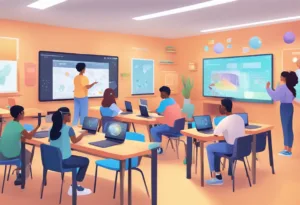
Interactive Learning Environments and Student Engagement
Augmented reality (AR) technology has the potential to improve student engagement in the classroom. By creating interactive learning environments, AR technology can help students visualize complex concepts and engage with the material in new ways. This technology can provide students with a more immersive learning experience, which can lead to increased engagement and better retention of information.
AR technology can also help educators create more engaging lesson plans. By incorporating AR technology into their lessons, educators can create interactive activities that allow students to explore and experiment with new concepts. This can help students stay engaged and motivated throughout the learning process.
Collaborative Projects and Social Learning
AR technology can also facilitate collaborative projects and social learning. By allowing students to work together in a shared AR environment, AR technology can help students develop teamwork and collaboration skills. This technology can also promote social learning, which can help students learn from each other and develop a deeper understanding of the material.
Collaborative AR projects can also help students develop problem-solving and critical-thinking skills. By working together to solve complex problems, students can learn how to think creatively and develop solutions that are more innovative and effective.
Incorporating AR technology into the classroom can help improve engagement and collaboration among students. By creating interactive learning environments and facilitating collaborative projects, AR technology can help students develop the skills they need to succeed both in and out of the classroom.
Assessment and Future Directions
Measuring Effectiveness and Learning Outcomes
When it comes to assessing the effectiveness of augmented reality (AR) in education, there are various methods and tools that can be used. Learning analytics is one such tool that can be used to track student progress and evaluate the effectiveness of AR-based learning activities. This involves collecting data on student engagement, performance, and behavior during AR activities, which can then be analyzed to identify patterns and trends.
In addition to learning analytics, usability evaluations can also be used to assess the effectiveness of AR-based learning activities. These evaluations involve testing the usability of AR applications and systems with actual users, and can help identify areas for improvement in terms of user experience and functionality.
Recent Advances and Research in AR Education
Recent research and development in AR education have focused on improving the usability and effectiveness of AR-based learning activities. For example, a systematic review of AR-based learning in STEM education found that AR can improve student engagement, motivation, and learning outcomes in these subjects.
Another recent survey of AR in education found that teachers and students alike perceive AR as a valuable tool for enhancing learning and engagement. However, the survey also identified several challenges to the adoption of AR in education, including a lack of training and support for educators, as well as technical and logistical issues with implementing AR-based learning activities.
Research in AR education is still in its early stages, but there is growing evidence to suggest that AR can be an effective tool for enhancing learning outcomes and engagement in a variety of educational settings. As AR technology continues to evolve and become more accessible, it is likely that we will see more widespread adoption of AR-based learning activities in the future.
Frequently Asked Questions
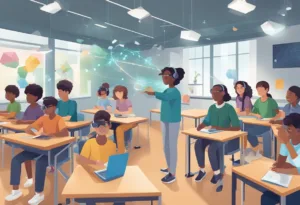
How is augmented reality used in education?
Augmented reality (AR) is used in education to create interactive and immersive learning experiences. AR technology overlays digital information such as sounds, videos, and graphics on top of the real-world environment. Teachers can use AR to enhance traditional teaching methods and make learning more engaging and interactive for students. AR can be used to simulate real-world scenarios, create 3D models, and provide visual aids that help students better understand complex concepts.
What is the future of augmented reality in education?
The future of augmented reality in education is promising. AR technology is still in its early stages, but it has already shown great potential in revolutionizing the way we learn. As AR technology becomes more advanced and accessible, we can expect to see more schools and universities adopting it as a teaching tool. AR can help bridge the gap between traditional classroom learning and real-world experiences, making learning more interactive and engaging.
What does AR mean in education?
AR in education refers to the use of augmented reality technology to enhance the learning experience. AR technology overlays digital information on top of the real-world environment, creating an interactive and immersive learning experience. AR can be used to simulate real-world scenarios, create 3D models, and provide visual aids that help students better understand complex concepts.
How do you incorporate AR into the classroom?
Incorporating AR into the classroom is easy. Teachers can use AR apps and tools to create interactive and immersive learning experiences for their students. AR can be used to simulate real-world scenarios, create 3D models, and provide visual aids that help students better understand complex concepts. Teachers can also use AR to create interactive quizzes and assessments, making learning more engaging and fun for students.
How can teachers use AR in the classroom?
Teachers can use AR in the classroom to create interactive and immersive learning experiences for their students. AR can be used to simulate real-world scenarios, create 3D models, and provide visual aids that help students better understand complex concepts. Teachers can also use AR to create interactive quizzes and assessments, making learning more engaging and fun for students.
Why use augmented reality in the classroom?
Augmented reality can provide a more engaging and interactive learning experience for students. AR can help students better understand complex concepts by providing visual aids and simulations. AR can also help bridge the gap between traditional classroom learning and real-world experiences, making learning more relevant and practical. By using AR in the classroom, teachers can create a more dynamic and immersive learning environment that helps students learn and retain information more effectively.

